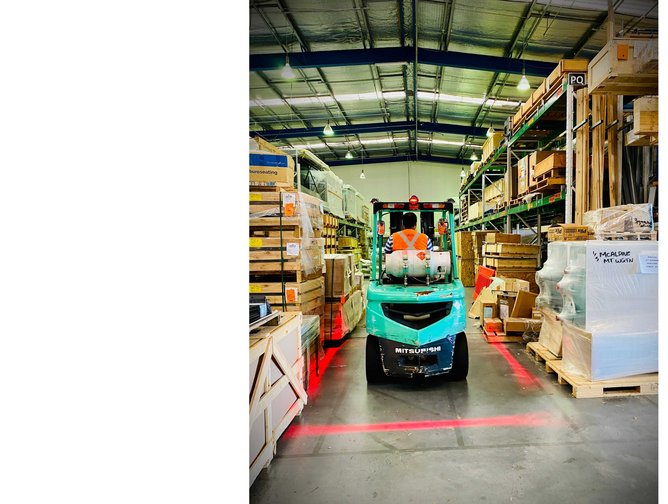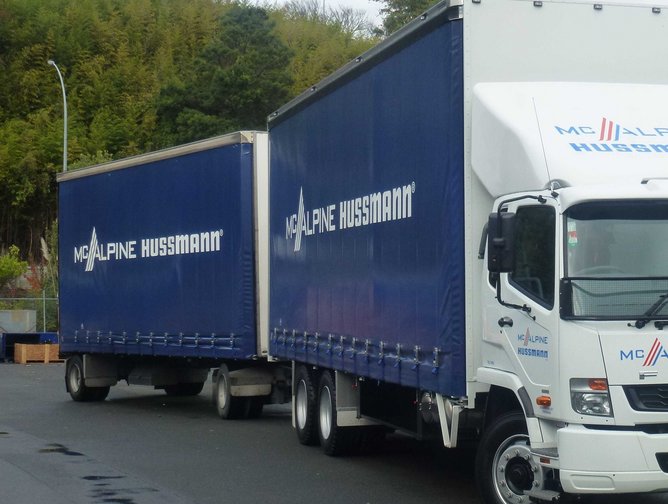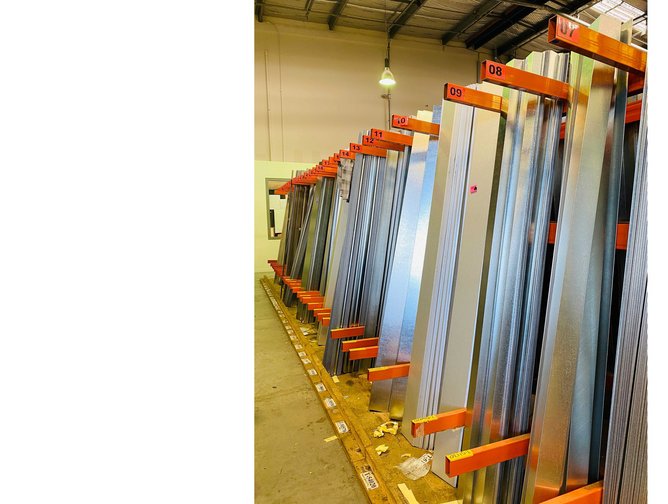Digital transformation in the McAlpine Hussmann supply chain
The modern company is only as good as its supply chain. Once the province of a monthly meeting by the accounting department - and otherwise left to the attention of a warehouse manager or individual department heads - supply chain management has undergone a radical transformation over the past decade. Driven by a global rise in ecommerce demand, a heightened need for efficiency and the increased potential for technology like AI and cloud computing, the supply chain space has rapidly become a key differentiator between successful companies and those destined for obsolescence.
Founded in the mid 1930s, New Zealand-based commercial refrigeration solutions provider McAlpine has been providing industry-leading services to the region for more than 85 years. Now a part of Hussmann Inc and owned by Panasonic, McAlpine Hussmann is undertaking a series of bold initiatives to digitally transform and radically modernise its supply chain.
“Up until now, the company hasn’t had a dedicated supply chain focus,” says Calum Laird, who has been serving as the Supply Chain Transition Manager at McAlpine Hussmann since February of this year. A supply chain, logistics and warehousing veteran, Laird has been brought on board by McAlpine Hussmann to orchestrate a multi-faceted transformation of the company’s supply chain that involves tackling warehouse management, a significant software implementation, redesigning procurement process and driving a cultural shift in a company with a long-serving employee base. “There’s a lot of history here, and a lot of people in the business have been here for 20 to 30 years,” he explains. “From a supply chain specific perspective, I’m involving and engaging with everybody that I can, because I know that there’s nothing worse than having some random newbie come in and say ‘this is how we’re doing things now.’”
We spoke with Laird to discuss the transition, and the ways in which harnessing the power of technology, procurement transformation and change management are poised to radically empower the McAlpine Hussmann supply chain to embrace the ideology of continuous improvement to further create value for its customers and clients. “There’s a four pillar workstream that I’m running with as part of this project,” Laird explains. “There’s procurement, warehousing, SAP and technology, and then people and culture.”
Warehousing and procurement
So far, McAlpine Hussmann’s procurement function has largely operated with a pre-Industry 4.0 methodology. “For a long time, because they know their product better than anybody, individual departments have been handling their own procurement,” says Laird. “It makes sense to some degree, but it also means that the synergies aren’t really there to streamline that activity and make it the most efficient operation that it can be.” One of Laird’s main goals revolves around the process of centralising the company’s procurement function. As companies scale, decentralised procurement strategies have a tendency to create silos which can create major logistical pain points. “Right now one of our major pain points concerns space constraints at our main warehouse in Auckland. Part of that stems from that decentralised procurement function where we’ve got different things happening in different divisions at the same time, but without everybody knowing about it at the same time,” says Laird. “We’ve got things that have been scheduled arriving at the same times as things that are a surprise to us.”
In a business like McAlpine Hussmann, this can be a particularly bitter pill, as the company operates by necessity on a project basis. “We obviously don’t just sit around with thousands of freezers waiting for someone to build a supermarket,” explains Laird. McAlpine Hussmann’s warehousing and procurement strategy relies on the company’s ability to receive product and then ship it out to be used in projects with a quick turnaround. “The actual stock we hold long term is predominantly spare parts. We’re talking about very small bits and pieces in storage and everything else is quite transitory,” he clarifies. “We might have 20 refrigerated display cases today and those might be gone tomorrow. Then, the day after that we’ll have a bunch of trough freezers on their way to a different supermarket. The transformation I’m overseeing right now is based around ensuring that this facility is able to manage a transient and ever-changing size and volume of cargo.”
The nature of this cargo can also prove challenging, Laird notes. Earlier in his career, he was part of the procurement function of one of New Zealand’s major beverage distributors. “Slinging beer and wine, for example, is easy because there’s standardised sizing pretty much across the whole world. It’s usually 672 750ml bottles of wine to a palette, or twice as many if you’re dealing with 375ml cans or bottles and if you buy and sell X-amount of wine, you know within a few millimeters how much space that’s going to take up,” he recalls. This contrasts massively to the variation across refrigeration or HVAC unit ranges, where the length, depth and height all vary more or less from unit to unit. “You’ve got everything from ice machines to serve-over cases and freezer troughs. The product range is monstrous,” he laughs. This diversity is further compounded by the fact that most of McAlpine Hussmann’s customers require customised products. “A particular supermarket might want to have a particular coloured bumper they want to use on the front of a unit for trolley protection. All these things are handled on a case by case basis,” Laird explains. “It wouldn’t be feasible for a company like McAlpine Hussmann to be sitting around with a hundred thousand square metre warehouse stacked full of all these ludicrously expensive and specialised units. It just wouldn’t work.”
Redistributing stock in a way that enables this fast turnover, highly transient style of warehouse operation is a key factor in successfully solving the company’s supply chain pain points. Laird notes that communication between business units and an amalgamation of procurement functions will go a long way towards ameliorating this situation. However, in order to create the visibility and cross-company data integration to support positive change, McAlpine Hussmann’s technological capabilities will also need to be overhauled.
Technology transformation
“While the space constraints and procurement transformation are very physical things we’re dealing with, we’re also rolling out a massive software and digital communications implementation as well,” says Laird. “We want to make sure that every part of our business is connected, interlinked and using every part of the technology that’s available.” At the heart of this implementation is McAlpine Hussmann’s adoption of SAP’s ERP, MRP, inventory management and warehouse management solutions. In turn these will be integrated with Salesforce’s CRM suite.
“The transition to SAP is going to put us light years ahead of where we have been. It allows for real time transfer of all information,” comments Laird. “Our technicians who are out on the road - if they need a particular part to fix a breakdown that they’ve been called to deal with - can look up the part and place an order directly from their phone, tablet or other device. They can then collect that from a local wholesaler, or our central warehouse in Auckland.”
The SAP integration means that information about part availability, stock levels and location can be updated across the entire system remotely. Laird expects this to be particularly useful in alleviating some of the pen and paper data entry that’s currently generating inefficiencies in the Auckland warehouse. “We operate a 24/7 repair and service model, which is a huge part of our business,” he explains. “We have technicians come into our warehouse at three in the morning who need a part. At the moment, they have to write down what they’ve taken on paper, and then someone comes in the next day and has to go enter that information into the system to make sure the stock is accurate. The flexibility and agility this gives our entire service team, as well as our back end supply chain and warehouse operators, is fantastic. We have all this added transparency in real time.”
It’s an ambitious project. The full SAP and Salesforce implementation has a go-live date in the first week of October this year. The integration means that there’s still a great deal of data to be cleansed, gathered, entered into the new system and double checked for accuracy. However, Laird is confident that the transformation will pay big dividends for McAlpine Hussmann, and can’t wait to prove it to the team. “We’re headed for a future where there’s direct interfacing between our customers, our suppliers and us, and working to make sure that the days of writing things down on bits of paper are a thing of the past,” he enthuses. “All these integrations mean that we’re building a culture where we not only rely on, but fully utilise the technology at our disposal to make sure we’re connected to our suppliers as well as our customers.”
People, partners and culture
Whether it’s within McAlpine Hussmann, across Panasonic’s global network, or throughout the company’s network of trusted suppliers and partners, Laird firmly insists that strong relationships are an essential part of doing business. “One of the things that’s highly important within our partner ecosystem is valuing quality relationships. That’s a value that McAlpine Hussmann was founded on and it continues to be vital today,” he says. Not only does the company work extensively with large-scale, global partners from within the Hussmann and Panasonic umbrella, but it places equal importance on its relationships with small, local businesses.
For over 10 years, McAlpine Hussmann has been working alongside RefSpecs, which supplies them with refrigeration units for the company’s projects. “Companies like RefSpecs really are a huge asset to our business in terms of enabling us to do what we do for our customers. They’re not a huge global corporate; they’re a wonderful, home grown, locally owned and operated New Zealand business. They’re nearby, agile and have a quick response time,” says Laird. “They’re very supportive of our business, and we like to make sure we’re supportive of theirs - as we are for all our suppliers and vendors.”
Looking inwards, Laird - like every digital transformation evangelist the world over - acknowledges that managing the cultural shift within the company is every bit as important to a successful transformation as software integrations, AI and cloud computing. To do this, he’s working to leverage the extensive industry knowledge of McAlpine Hussmann’s veteran team, hoping to empower them to not only solve existing problems, but to develop a passion for tech-driven transformation. “If there’s anyone I need to learn from and leverage knowledge from, it’s these highly experienced and knowledgeable people. They know our products, customers and processes inside and out. By engaging their support, as well as highlighting the benefits of things like our move to SAP, we can benefit one another,” he explains. “Any level of automation and increased visibility throughout a business by way of software is a great thing for efficiency. I think that some of the people that we’re working with haven’t been exposed to that kind of thing before, and that’s ok - it’s just a matter of making sure that they understand that no one’s trying to replace anyone with robots.”
Going Forward
Looking to the future, Laird is optimistic about the cultural changes that he hopes to effect at McAlpine Hussmann. “I would like to be able to instill a culture by way of proof. I need to show the business just how many benefits they’re going to start seeing to their supply chain when these implementations start coming to fruition,” he says. “It won’t all happen at once. I think that ERP, MRP, inventory management and WMS, plus CRM is probably enough implementation for one year. At the end of my tenure, I want to be able to say that this business truly understands and embraces continuous improvement, the digital space and the potential of cloud software, AI and technology.”







